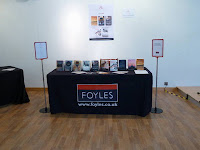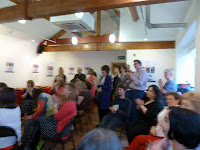by Catriona Troth
Triskele Books are all about Time and Place - so how do writers evoke a sense of place?
Last September, I wandered, more or less by chance, into the
Writing Britain exhibition at the British Library. From their vast collection of books, manuscripts, audio and photographs, the Library had assembled a panoramic view of how writers from the Middle Ages to the present day have represented the British landscape.
It began by evoking rural, agricultural landscapes - from ancient stories of the Green Man to a recording of Stella Gibbons' talking about
Cold Comfort Farm and a hand drawn map of the locations in Winifred Holtby's
South Riding. From there, you moved on to the section entitled 'Dark Satanic Mills,' the literature of factories and labour from Elizabeth Gaskell's
North and South, set in the early days of the industrial revolution to Ted Hughes' collaboration with the photographer Fay Godwin, charting the decay of the old mills and chimneys.
The ‘Wild Places’ section of the exhibition was screened with panels of white fabric marked with steep contour lines. Here were manuscripts from the Romantic Poets, a copy
Lorna Doone and a recording of Daphne du Maurier describing how she first stumbled on Jamaica Inn on her horse, seeking shelter from a storm.
‘Beyond the City’ celebrated suburbia in books such as
The Rotters Club, Metroland and
The Buddha of Suburbia. In the section on London, detailed street maps covered surfaces around the exhibits and hung from baffles above your head. The most immersive experience of all was in ‘Waterlands’, where video screens showed images of coasts, rivers and lakes, and you were surrounded by the sound of lapping waves.
All this made me think about books that evoke the British landscape for me. I was born in Scotland, but I grew up in Canada, so for many years my images of Britain were almost entirely drawn from what I read.
It began, I suppose, with
The Borrowers. I never really understood why I adored Mary Norton's stories so completely, until as an adult I bought an omnibus edition with a foreword in the form of a letter she had once written to a young fan. In it she described growing up as the short-sighted sister of three long-sighted brothers, forever focused on the tiny details of the Leicestershire hedgerows as her brothers vainly tried to show her hawks wheeling in the sky. I had grown up as the short-sighted daughter of a long-sighted mother, and I knew exactly what she meant.
After The Borrowers came
Swallows and Amazons. I fell in love with Ransome's Wild Cat Island and Katchenjunga ten years before I ever set foot in the Lake District, and I still get a thrill when I catch a glimpse the steamer on Windermere that is recognisably Captain Flint's Houseboat.
Unlike his Lake District, which is a conflation of Lake Windermere and Coniston Water, Ransome's portrayal of the Norfolk Broads is so accurate you can follow the adventures of the
Coot Club step by step on a map. My husband would have done well to have read about Tom's narrow escape passing through Yarmouth as the tide was running out before he attempted the same with some friends from university. I have never been to the salt marshes around Harwich, but from
Secret Water, I have a vivid image of the 'Mastadon' paddling over the soft mud flats wearing something like flat wooden snow shoes, and of Titty, Roger and Bridget almost trapped on the Wade as the tide sweeps back in.
I live not that far from the Thames now, but before I ever set foot in them, I knew Marlow and Maidenhead, Cookham and Goring from the lyrical descriptions in Jerome K Jerome's
Three Men in a Boat (which he would immediately undermine with some piece of grumpy absurdity that would have me howling with laughter).
We went through Maidenhead quickly, and
then eased up, and took leisurely that grand reach beyond Boulter’s and Cookham
locks. Cliveden Woods still wore their dainty dress of spring, and rose
up, from the water’s edge, in one long harmony of blended shades of fairy
green. In its unbroken loveliness this is, perhaps, the sweetest stretch
of all the river, and lingeringly we slowly drew our little boat away from
its deep peace.
Oxford was painted for me by Dorothy Sayers in
Gaudy Night (in colours that were probably idealised even in 1935).
Mornings in Bodley, drowsing among the
browns and tarnished gilding of Duke Humphrey, snuffing the faint, must odour
of slowly perishing leater, hearing only the tippety-tap of Agag-feet along the
padded floor; long afternoons, taking an outrigger up the Cher, feeling the
kiss of the sculls on unaccostomed palms…
I knew the mountains of Wales from my mother's beloved
Under Milk Wood.
By Cader Idris, tempest-torn,
Or Moel yr Wyddfa's glory,
Carnedd Llewelyn beauty born,
Plinlimmon old in story,
By mountains where King Arthur dreams,
By Penmaenmawr defiant,
Llaregyb Hill a molehill seems,
A pygmy to a giant.
There are places I have never been, or only passed through, that have been made real for me through the pages of a book. There can surely be no better evocation of Eastern Scotland than William Grassic Gibbons'
Sunset Song (which is surely impossible to read without hearing it in a soft, Aberdeenshire accent).
But for days now the wind had been in
the south, it shook and played in the moors and went dandering up the
sleeping Grampians, the rushes pecked and quivered about the loch when its
hand was upon them, but it brought more heat than cold, and all the parks
were fair parched, sucked dry, the red clay soil of Blawearie gaping open
for the rain that seemed never-coming.
The Clean Air Act came in a few years after I was born, so I never experienced the London Peasoupers that blighted my father's childhood. But I've lived through them in the opening passages of Dickens'
Bleak House.
Implacable November weather. As much
mud in the streets as if the waters had but newly retired from the face of the
earth, and it would not be wonderful to meet a Megalosaurus, forty feet long or
so, waddling like an elephantine lizard up Holborn Hill. Smoke lowering down
from chimney-pots, making a soft black drizzle, with flakes of soot in it as
big as full-grown snowflakes - gone into mourning, one might imagine, for the
death of the sun. Dogs, undistinguishable in mire. Horses, scarcely better;
splashed to their very blinkers...
Fog everywhere. Fog up the river, where
it flows among green aits and meadows; fog down the river, where it rolls
defiled among the tiers of shipping and the waterside pollutions of a great
(and dirty) city…
Books shape the way we remember too. I was born in Edinburgh, but today the city for me is a joint creation of Ian Rankin and Alexander McCall Smith. My mother was transported back to Anglesey, the home she left more than sixty years ago, by the descriptions in Gillian Hamer's
Charter. And nothing, but nothing, has brought back what it felt like to arrive back in Britain from North America in the mid-seventies than the opening chapter of Bill Bryson's
Small Island.
Surprisingly, a writer does not have to be a native or even long-term resident to be able to conjure a time and place to vivid life. The author of
The Guernsey Literary and Potato Peel Pie Society only ever spent one day stranded by fog on the island. Sarah Waters'
The Night Watch helped me to understand, as nothing else had, the realities of living through the London Blitz, though she was born in twenty years after the War ended. Michel Faber’s portayal of the seamier side of Victorian London in
The Crimson Petal and the White is as beguiling as Dickens’.
I guess the lesson for writers here is – write about the places you love, yes; make others love them too. But don’t be afraid to set your imagination free. The landscapes of the mind are the best ones of all.

















